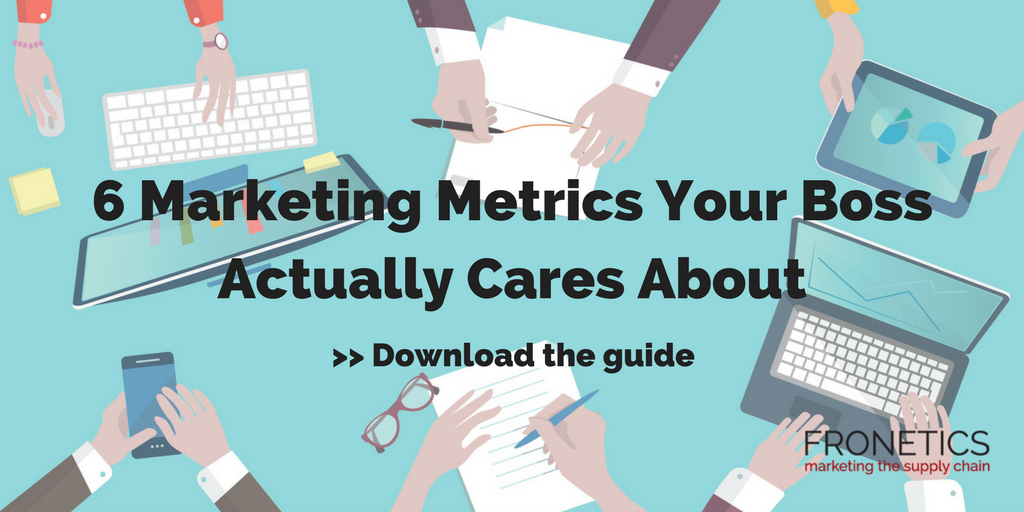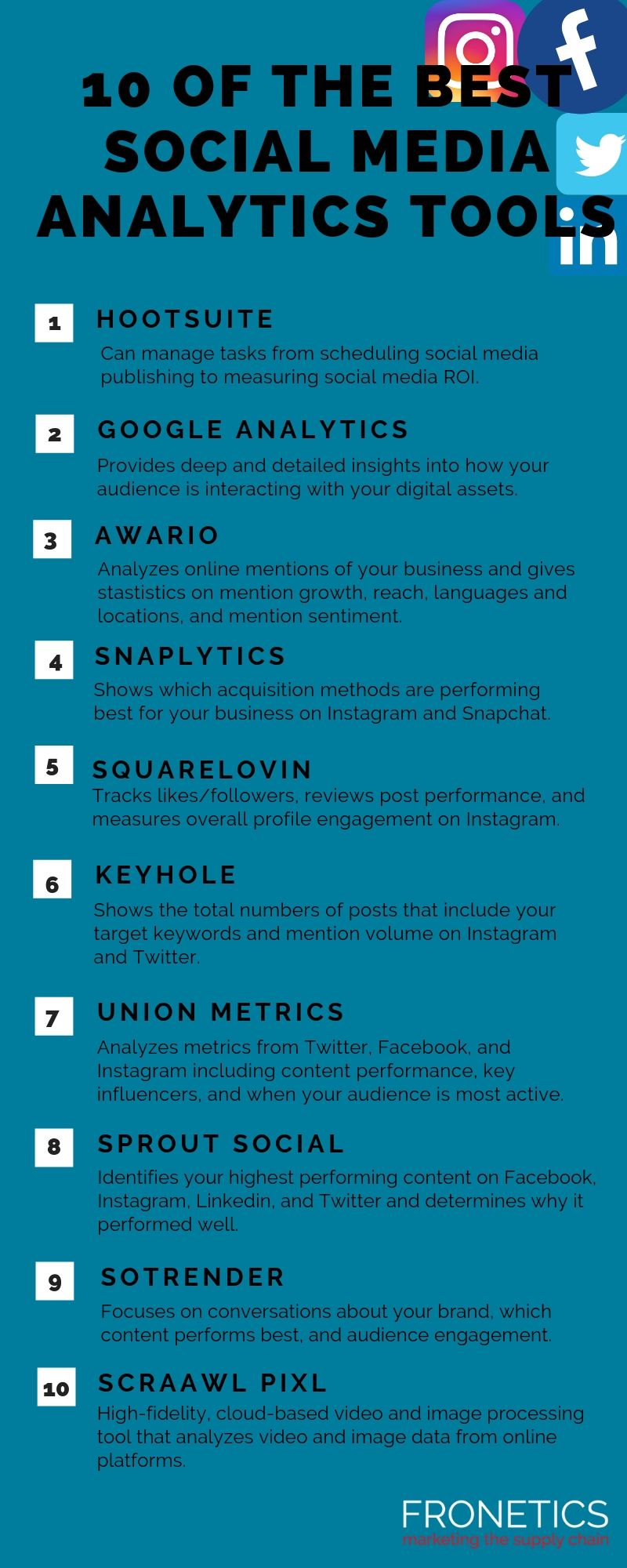
by Fronetics | Jun 19, 2019 | Blog, Content Marketing, Current Events, Logistics, Marketing, Supply Chain
As the internet is increasingly dominated by visual content, social media analytics are failing to keep up.
Highlights:
- Most social media analytics tools are purely text-based.
- Even tools that analyze images are costly and offer limited insights.
- We predict that machine learning capabilities will improve and the gap between analytics capability and brands’ needs will close.
Here’s an interesting conundrum: social media, and the web at large, is becoming increasingly visual, and social media marketing relies on increasingly sophisticated analytics. However, most of the analytics tools out there are woefully unable to make sense of the visual content that is dominating social media. The alarming truth is that social media analytics are failing to capture invaluable data on visual content.
How social media analytics are failing to keep up
Big data and artificial intelligence expert Kalev Leetaru describes the shortfalls of social media analytics by detailing what they can — and can’t — do. While the capabilities of visual analytics have grown in the past several years, as Leetaru points out, most analytics tools that claim to analyze visual images are in fact based on textual or structural aspects of the image, not the visual content itself.
“The overwhelming majority of production social media analytics research relies primarily on hashtags and associated caption text, rather than the actual contents of the images themselves,” writes Leetaru. Instead, “from simplistic bag of words counting algorithms through advanced deep learning approaches, it is text that forms the lens through which we see social media.”
It’s important to note that this text-based approach is true not only for social media analytics, but for search engine algorithms. At Fronetics, we are constantly advising our clients to make use of visual content, from images to infographics to video, in their digital marketing efforts. But we always advise that marketers optimize their images for search engines, both by tagging all visual assets and publishing transcripts to go along with video or infographics.
In essence, we’re advising our clients to take advantage of the increasingly visual nature of the internet, while also hedging against the ways in which algorithms and social media analytics are failing to assess visual content. As Leetaru points out, even in the rare cases when an analytics tool offers image analysis, it “typically offers only a few basic lenses through which to analyze that content, such as logos and a small number of topics.”
Of course, analyzing visual content is no easy task, and it’s also not cheap. “Images don’t capture reality, they construct it,” observes Leetaru. Not only are there all kinds of variables, like framing or lighting, that come into play, but there is a tremendous amount of non-visual context that determines how an image will be received. And the fact is that “current deep learning approaches are largely unable to incorporate such external world knowledge into their assessments.”
The problem with analytical failure
It’s important for marketers to recognize that, at the current moment, there is a gap between the capabilities of analytics tools and the analytics needs for modern digital marketing. As we as a society “increasingly express ourselves exclusively through visual forms,” brands desperately need insights about this visual expression.
Leetaru sums up the problem with sobering simplicity: “As social media becomes more visual, it becomes less accessible to our data-mining algorithms. In turn, as social media is less and less data minable, we are less and less able to understand it.”
Perhaps even more alarmingly, he cautions that “given that visual expression skews towards the younger and influencer demographics of greatest interest to many brands, this transition is especially damaging to their ability to extract useful insights from social media.”
Essentially, what Leetaru is recognizing is that we’re at a perilous moment for digital marketing. Just when the possibilities for content creation and dissemination seem endless, social media analytics are failing to offer up the insights needed to shape these processes in an increasingly visual climate.
“In the end, as social platforms rush towards a visual-first world, the vast landscape of social analytics is getting less and less representative of what we’re really talking about,” concludes Leetaru.
What does the future hold for analyzing visual data?
While you may be thinking that the future looks pretty bleak in light of how social media analytics are failing us, there’s a silver lining. If there’s one constant when it comes to social media marketing, it’s that when there’s a demand, sooner or later, supply will catch up.
It’s true that the current visual analytics capabilities of most platforms are far behind what’s needed. But at Fronetics, we predict that deep machine-learning capacities will start to catch up, and increasingly sophisticated analytical capabilities will become available to a wider segment of the market.
Currently, social media analytics can recognize text, faces, and brand logos within images. While these capabilities are, at present, too costly for most companies to take advantage of, we’re keeping our eye on some emerging technologies. For example, analytics provider Scraawl has recently released a tool called Scraawl PixL, which will allow users to run object and face detection, as well as Optimal Character Recognition, which extracts text from images.
Expect to see more tools like PixL on the market, offering increasing sophistication. While social media analytics are failing to keep up with the onslaught of visual data at the moment, we predict that they won’t be behind for long.
Related posts:


by Fronetics | Jun 18, 2019 | Blog, Content Marketing, Logistics, Marketing, Strategy, Supply Chain, Website Development
The percentage of visitors that stay on your site is key to lead conversion and search engine rankings. Here are our top tips to reduce your website bounce rate.
Highlights:
- A high bounce rate will compromise your site’s search engine rankings.
- Slow website load times are a major cause of bounces.
- Publish high-quality, visually appealing content with relevant keywords and meta data.
When it comes to evaluating the performance of your website, bounce rate is a key indicator. But what does this term really mean for supply chain marketing? After we take a deeper dive into what a bounce rate is and why it’s important to track, we’ll offer 10 ideas to reduce your website bounce rate.
Bounce rate defined
Simply put, your website’s bounce rate is the percentage of users who enter your website and immediately leave, or “bounce,” without visiting any additional pages on your site. Bounces happen when visitors click the back button, navigate to a different URL, close their browser, or leave a page open without taking action.
Having a high bounce rate can be an indication that your site failed to convince the visitor to explore further or act on your call-to-action (CTA). Of course, no website, no matter how effective, has a 0% bounce rate. Some users are bound to leave your website without taking any action. But a healthy bounce rate is a key indicator of website success.
While bounce rate ranges vary based on industry and page type, the general ranges are:
- 80% or higher: bad
- 70%-80%: poor
- 50%-70%: average
- 30%-50%: excellent
- 20% or lower: likely a tracking error
However, the truth about good versus bad bounce rates is more nuanced than these ranges. Bounce rates can vary widely based on website type, channel, and the device visitors are using.
For example, blog posts typically have a high bounce rate (between 60% and 90%), simply because an effective post will give a user what he or she came for, and there’s no further need to explore your site. This doesn’t mean your blog is performing poorly, as bounce rate is just one in a list of metrics needed to assess the overall performance of a site.
Why does bounce rate matter?
Aside from the fairly obvious fact that a high bounce rate means that visitors aren’t being converted into customers on your site, there’s another serious ramification to your bounce numbers: search engine results. According to a recent study from SEMRush, “Bounce rate is the fourth most important ranking factor on search engine results pages.”
Every time a visitor bounces from your page, it signals to search engine algorithms that your site isn’t what the searcher was looking for, and your ranking will suffer. Having a handle on your bounce rate will help you form a clear picture of how your website is performing, as well as give you understanding of one of the key factors in determining your search engine ranking.
10 ways to reduce your website bounce rate
1) Keep an eye on your page load times.
A major cause of bounces is long loading times, particularly on mobile devices. If your page load time is slow, consider switching to HTTP/2.
2) Make sure navigation is easy.
For your website to entice visitors to stick around, it needs to be clearly labeled and easy for prospects to find and get to what they’re looking for.
3) Evaluate your first impression.
You only get one first impression. When it comes to your website, this means clear navigation menus, engaging headlines, easy-to-read text, subheadings and bullets, and minimal pop-ups or auto-play videos.
4) Publish high-quality content.
Perhaps this goes without saying, but there’s no substitute for high-quality content when it comes to keeping visitors engaged on your site.
5) Optimize your meta data.
A meta description is the text that appears below your website’s URL in search engine results. This text should accurately represent what the page contains, which helps ensure that visitors find what they’re looking for when they click.
6) Create a quality design.
Clean, compelling design is important for keeping users on your page. Ideally, your site’s design should not only be functional and intuitive, but aesthetically pleasing.
7) Optimize mobile experience.
Bearing in mind that mobile users typically have even less patience than desktop users, your site’s mobile version should have a quick load speed, clean design elements, and easy navigability.
8) Use relevant keywords.
The keywords you choose should not only be relevant to your audience’s search queries, but they should reflect what visitors will actually find on your site. If your site ranks high for a keyword that doesn’t relate to the majority of your content, then users searching for that keyword will quickly leave.
9) Write good calls-to-action (CTAs).
A good CTA is key not only to converting leads but also to reducing your website bounce rate. Ideally, your CTA should be clearly visible within the first few seconds of being on a page, and it should be compelling.
10) Use images and videos.
We live in a visual world, so naturally, this type of content connects best with users. Statistic after statistic supports the idea that visual content is dominating the internet. To reduce your website bounce rate, include visuals that keep your audience interested.
What tricks are you using to reduce your website bounce rate?
Related posts:
Is your business making the most of its web presence?
Get a free website audit
Discover untapped opportunities and places you may be losing leads with our free website audit.

by Fronetics | Jun 13, 2019 | Blog, Content Marketing, Leadership, Logistics, Marketing, Supply Chain, Talent
A new LinkedIn post takes a refreshing look at achieving a work-life balance for working parents. The article has been shared all over social media begging the question: does your office need to know?
The New York Times reported that more and more couples are choosing to have smaller families due to economic factors. Let’s face it: kids are expensive. Most families have to balance wages with the exorbitant cost of childcare.
And that doesn’t even begin to look at finding harmony between your career and your family. In a recent post on LinkedIn, Ian Sohn, a single father and president of Wunderman Chicago, takes a clever and honest look at creating a work-life balance, a juggling act many of us know all too well.
“You should never apologize for having a life.”
The post was a list of things this Chicago-based boss ‘never needs to know’ about his employees, including:
- I never need to know you’ll be back online after dinner.
- I never need to know that you’re working from home today because you simply need the silence.
- I never need to know why you chose to watch season 1 of “Arrested Development” (for the 4th time) on your flight to LA instead of answering emails.
- I never need to know you’ll be in late because of a dentist appointment. Or that you’re leaving early for your kid’s soccer game.
- I never need to know why you can’t travel on a Sunday.
- I never need to know why you don’t want to have dinner with me when I’m in your town on a Tuesday night.
The sentiments of Sohn’s post hit home with a lot of working parents — the post has almost 2,000 comments to date. So why does this list ring true for so many working mothers and fathers?
“Like any modern business … there’s an additional need to respect other people’s lives and environment you work in, and everyone is accountable for getting their job done,” says Sohn in USA Today.
As businesses have become more digital, the ability to do you work remotely has increased. Ask any employee who works remotely, and they’re very likely to tell you that working from home makes them happier and more productive. And they aren’t necessarily wrong. There’s certainly evidence to suggest that with today’s technology, there’s essentially no downside to working from home, and it does often enhance productivity.
Here at Fronetics, we believe, much like Sohn, in the balance between work and home life. As individuals, we strive to excel at our jobs through accountability. Have a doctor’s appointment? Need to attend a school performance? We don’t need to know.
Has your office implemented policies to encourage flexibility? Has it been successful?
Related posts:


by Fronetics | Jun 11, 2019 | Blog, Content Marketing, Logistics, Marketing, Social Media, Supply Chain
An effective social media strategy requires data. Here are our 10 favorite social media analytics tools to empower you with insights that will boost your social media game.
Highlights:
- Hootsuite and Sprout Social are all-around social media management tools that offer analytics.
- Google Analytics is an overall powerhouse tool to track the performance of all your digital assets.
- Newcomers to the list include Awario, Squarelovin, Keyhole, and image analytics tool PixL.
At Fronetics, we believe in a data-driven approach to digital marketing. A solid analytical framework has the potential to offer insights that will shape and refine your strategies, increasing your ability to generate, nurture, and convert leads. We’ve pulled together 10 of the best social media analytics tools to help you determine what’s working and what’s not — and to empower you to develop a data-driven strategy.
Our 10 favorite social media analytics tools

(Made with Canva)
1) Hootsuite
There are so many tools out there, and our internal list of the best social media analytics tools often shifts. But there are a few platforms that always make the list, and Hootsuite is one of them. It’s one of the most popular social media management tools for a reason – it’s a powerhouse that can manage tasks from scheduling social media publishing to measuring social media ROI.
Hootsuite gives you key metrics from Twitter, Facebook, and Instagram with audience and post insights, as well as performance data. It packages all the data in approachable charts and graphs. One of our favorite features is the AutoSchedule tool, which lets Hootsuite determine the optimal time to post or tweet based on when similar content performed well in the past.
2) Google Analytics
Another of our perennial favorites, Google Analytics is a robust platform that can provide deep and detailed insights into how your audience is interacting with your digital assets, including social media. This is one of the best social media analytics tools out there, and we’ve written extensively about how to get the most out of it.
For social media analytics, we particularly recommend three custom reports: Best Days to Post on Social Media, Best Time to Post on Social Media, and the Social Media Traffic by Date and Hour. These three reports offer real-time data, along with the in-depth insight you need to help your business optimize its social media strategy.
3) Awario
Awario analyzes online mentions of your business and gives you statistics on mention growth, reach, mentions’ languages and locations, mention sentiment, and where on the web mentions are occurring. We particularly appreciate that the tool also identifies social media users who have used your keywords and provides you with a list of social media influencers in your specific area.
Benchmarking your social media marketing strategy against your competitors is key to understanding how you’re doing. Awario lets you create alerts for your main competitors and offers you a step-by-step comparison of your social media performance against theirs.
4) Snaplytics
While all-inclusive tools like Hootsuite and Google Analytics are excellent for evaluating your overall social media strategy, we also recommend a few tools that focus on specific platforms. Snaplytics hones in on Instagram and Snapchat, including offering insights on Instagram Stories.
For both networks, Snaplytics shows you which acquisition methods are performing best for your business, as well as what precipitates rises and falls in engagement levels. Snapchat can be a tricky platform for brands, and Snaplytics provides the kinds of insights you need to make inroads on this millennial-dominated network.
5) Squarelovin
We’ve written extensively about how supply chain companies can make the most of Instagram and Instagram Stories. Squarelovin is an analytics tool specifically for Instagram that provides you with the data you need to optimize your strategy. It tracks likes and followers, reviews post performance, and measures overall profile engagement.
One of the best social media analytics tools for Instagram out there, Squarelovin highlights the best times to post, ideal filters to use, and most popular hashtags. It also gives you a history of engagement with your posts, broken down by hour.
6) Keyhole
This social media monitoring tool offers up deep analytics for Twitter and Instagram. Keyhole will show you the total number of posts that include your target keywords, as well as how mention volume has changed over time. It displays engagement data, hashtag usage trends, sentiment metrics, and reach statistics.
Influencers are key on Instagram and Twitter, and influencer marketing should be part of your social media strategy. Keyhole provides insights into influencers and trends in your specific niche, along with audience demographics and locations.
7) Union Metrics
Union Metrics analyzes a range of metrics from Twitter, Facebook, and Instagram. Like Hootsuite, it lets you know which content is performing best across each platform, the times when your audience is most active throughout the day, and who your key influencers are.
What really sets Union Metrics apart is in its potential for optimizing content creation. The tool goes above and beyond by tracking relevant trends to help you generate ideas for new content, based on hard performance data.
8) Sprout Social
Sprout Social is probably Hootsuite’s biggest competitor, and it’s another of our frequent favorites. Like Hootsuite, it’s an all-around social media management tool that provides key analytics as well. It measures performance and engagement across Facebook, Instagram, LinkedIn, and Twitter and benchmarks your data against competitors.
Sprout Social also helps you identify your highest performing content and determine why it has performed well. It can also show you how your paid ads are performing through a comparison of paid versus organic impressions and followers gained.
9) Sotrender
This formidable social media analytics tool shows you where conversations about your brand are happening, which of your content performs best, and how your audience engages with your social media content. Sotrender analyzes Twitter, YouTube, Facebook, and Instagram and makes it easy for you to benchmark your efforts against your competitors.
We like any tool that not only offers data but gives you advice for improving your strategy. Sotrender offers customized tips on where your marketing strategy needs improvement, based on the analysis it performs.
10) Scraawl PixL
As the internet, and social media in particular, becomes more visual, experts have pointed to a dearth of analytics tools with the capability to perform rich analysis on images. Scraawl PixL is a relatively new kid on the block, and it’s attempting to fill the void when it comes to image-based analytics.
This high-fidelity, cloud-based video and image processing exploitation tool offers an easy-to-use interface, as well as workflows for analyzing video and image data from online digital platforms. It relies on machine learning-based algorithms that enable face detection and recognition as well as object detection, tracking, and classification.
What are your favorite social media analytics tools?
Related Posts:


by Fronetics | Jun 6, 2019 | Blog, Content Marketing, Leadership, Logistics, Marketing, Supply Chain
Here are 5 books for supply chain professionals to gain insights about the industry and leadership practices.
Highlights:
- There’s no substitute for the in-depth analysis and explanation made possible by the long-format of a book.
- Leadership and professional growth means learning from the perspectives and insights of others.
- This year’s list includes works by Richard J. Sherman, Steven Bowen, and Edward H. Frazelle.
There’s no question that we live in a digital age, with information on almost any topic quickly accessible at our fingertips. But even in this age of short soundbites and reductively simplistic explanations, there’s no substitute for the value of sustained analysis and critical insight. To that point, we’ve put together a list of five books for supply chain professionals.
The supply chain leaders and analysts whose books are on this list each bring unique skills, perspectives, and approaches to the table. Being your best professional self means learning from the successes, failures, and insights of others. Add these five books to your summer reading list, and let us know how they make an impact on your professional life.
5 books for supply chain professionals
1) Strategic Supply Chain Management: The Five Core Disciplines for Top Performance, Second Edition
Co-authored by Shoshanah Cohen and Joseph Roussel, this classic guide to supply chain strategy has been re-created to help business leaders gain an advantage in today’s volatile, globalized arena. The global landscape has changed dramatically since the first edition of Strategic Supply Chain Management established itself as the authority on creating value and achieving competitive advantage from the supply chain.
This second edition is your answer to gaining a strategic advantage in the face of these challenges. Drawing on dozens of new company examples as well as cutting-edge benchmarking research, it shows you how to make your supply chains more agile, flexible, and resilient.
2) Supply Chain Transformation: Practical Roadmap to Best Practice Results
Much is being written about global supply chain and sourcing options emerging in today’s marketplace. Transforming supply chain management to achieve operational excellence is a mandate for many companies globally. Supply Chain Transformation, written by Richard J. Sherman, walks you through this potentially difficult process and gets you started on the journey.
Much more than just a how-to book, it’s a why-to book that is as compelling for any business person as it is for supply chain management professionals. This book provides an invaluable road map to companies looking to transform their supply chains and organizations to achieve best practice results, beginning with guidance on how to make the case for change. Change is inevitable; growth is optional.
3) Total Value Optimization: Transforming Your Global Supply Chain into a Competitive Weapon
Today’s corporate leaders are under increasing pressure to deliver differentiated, lasting performance, fast. New business models are continuously cropping up, with competitors becoming more numerous, more formidable, and more global. This puts profitability at risk as whole supply chains shift in industries.
Steven Bowen provides a clear pathway to transforming supply chains into the ultimate competitive weapons. Bowen’s method, which he calls Total Value Optimization, places customer value at the heart of the business-model, through a demand-driven digital supply chain. Grounded in data analytics, Total Value Optimization is essential for companies looking to survive and thrive in today’s fast-paced and ever-changing business environment.
4) Designing and Managing the Supply Chain – Third Edition
Designing and Managing the Supply Chain provides state-of-the-art models, concepts, and solution methods that are important for the design, control, operation, and management of supply chain systems. In particular, authors David Simchi-Levi, Philip Kaminsky, and Edith Simchi-Levi attempt to convey the intuition behind many key supply chain concepts and to provide simple techniques that can be used to analyze various aspects of the supply chain.
Topical coverage reflects the authors’ desire to introduce readers to those aspects of supply chain management that are critical to the success of a business. Although many essential supply chain management issues are interrelated, the authors strive to make each chapter as self-contained as possible, so that the reader can refer directly to chapters covering topics of interest.
5) Supply Chain Strategy, Second Edition: Unleash the Power of Business Integration to Maximize Financial, Service, and Operations Performance
The industry standard in supply chain management, Supply Chain Strategy’s Second Edition is fully revised and updated to provide today’s logistics solutions. The proven pillars of success in logistics and supply chain management introduced in the first edition of Supply Chain Strategy now guide the supply chains of many of the world’s most successful organizations.
Written by Edward H. Frazelle, Supply Chain Strategy includes up-to-date case studies showing how some of the world’s most successful companies meet supply chain goals and helps you overcome your own challenges with the latest supply chain innovations, including big-data analytics, supply chain command and control centers, large-scale supply chain optimization, integrated supply chain planning, and real-time global supply chain visibility.
Bonus read: “First: Sandra Day O’Connor”
No, Evan Thomas’ bio of Justice Sandra Day O’Connor doesn’t specifically relate to the supply chain. But if you’re looking for inspiring reading on leadership, overcoming adversity, and empowering women in the workplace, this newly released biography of the first female Supreme Court Justice is an excellent read.
What books for supply chain professionals have you read recently?
Related posts:










